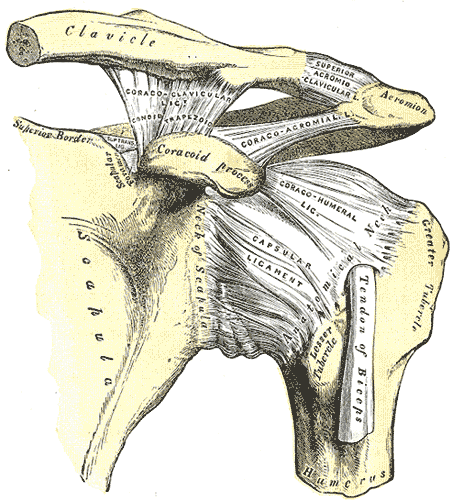Dislocated shoulder
| Dislocated shoulder | |
 | |
|---|---|
| The left shoulder and acromioclavicular joints, and the proper ligaments of the scapula. | |
| ICD-10 | S43.0 |
| ICD-9 | 831 |
| DiseasesDB | 31231 |
| eMedicine | orthoped/440 radio/630 sports/152 |
| MeSH | D012783 |
Editor-In-Chief: C. Michael Gibson, M.S., M.D. [1]
Overview
A dislocated shoulder occurs when the humerus separates from the scapula at the glenohumeral joint. As the most maneuverable joint in the human body, the shoulder is the joint most vulnerable to dislocation. Approximately half of major joint dislocations seen in emergency departments are of the shoulder. Partial dislocation of the shoulder is referred to as subluxation.
Types
Anterior (forward)
Over 95% of shoulder dislocation cases are anterior. Most anterior dislocations are sub-coracoid. Sub-glenoid; subclavicular; and, very rarely, intrathoracic or retroperitoneal dislocations may occur.[1]
Posterior (backward)
Posterior dislocations are occasionally due to electrocution or seizure and may be caused by strength imbalance of the rotator cuff muscles. Posterior dislocations often go unnoticed.[2] An average interval of 1 year was discovered between injury and diagnosis of posterior dislocation in a series of 40 patients.[3]
Inferior (downward)
Inferior dislocation is the least likely form, occurring in less than 1% of all shoulder dislocation cases. This condition is also called luxatio erecta because the arm appears to be permanently held upward or behind the head.[4] It is caused by a hyper abduction of the arm that forces the humeral head against the acromion. Inferior dislocations have a high complication rate as many vascular, neurological, tendon, and ligament injuries are likely to occur from this kind of dislocation.
Signs
- Significant pain, which can sometimes be felt past the shoulder, along the arm.
- Inability to move the arm from its current position, particularly in positions with the arm reaching away from the body and with the top of the arm twisted toward the back.
- Numbness of the arm.
- Visibly displaced shoulder. Some dislocations result in the shoulder appearing unusually square.
Treatment
Initial
Prompt professional medical treatment should be sought for any suspected dislocation injury. A dislocated shoulder should be kept in its current position by use of a splint or sling. A pillow between the arm and torso may provide support and increase comfort. Ice may help reduce pain.[5]
Emergency department care is focused on returning the shoulder to its normal position via processes known as reduction. Normally, closed reduction, in which several methods are used to manipulate the bone and joint from the outside, is used. A variety of techniques exist, but some are preferred due to fewer complications or easier execution.[6] In cases where closed reduction is not successful, surgical open reduction may be needed.[7] Following reduction, X-Ray imaging is often used to ensure that the reduction was successful and there are no fractures. The arm should be kept in a sling or immobilizer for several days, preferably until orthopedic consultation.
Therapy
In many cases, particularly for individuals not subject to high occupational risk of dislocation, physical therapy can strengthen the shoulder and produce satisfactory shoulder stability.
Surgery
Some cases require non-emergency surgery to repair damage to the tissues surrounding in the shoulder joint and restore shoulder stability. Arthroscopic surgery techniques may be used to repair the glenoidal labrum, capsular ligaments, biceps long head anchor or SLAP lesion and/or to tighten the shoulder capsule. [8].
The time-proven surgical treatment for recurrent anterior instability of the shoulder is a Bankart repair [2]. When the front of the shoulder socket has been broken or worn, a bone graft may be required to restore stability [3]. When the shoulder dislocates posteriorly (out the back), a surgery to reshape the socket may be necessary [4].
See also
External links
- dislocated shoulders at Mayo Clinic
- Arthroscopic shoulder surgery for shoulder dislocation, subluxation, and instability: why, when and how it is done. at University of Washington
- emedicinehealth.com Patient education article -- Shoulder Dislocation
References
- ↑ http://www.emedicine.com/orthoped/topic440.htm
- ↑ http://www.emedicine.com/emerg/topic148.htm
- ↑ http://www.medscape.com/medline/abstract/3805075?src=emed_ckb_ref_0
- ↑ http://www.emedicine.com/emerg/topic148.htm#section~clinical
- ↑ http://www.mayoclinic.com/health/dislocated-shoulder/DS00597
- ↑ http://www.emedicine.com/emerg/topic148.htm#section~workup
- ↑ http://www.mayoclinic.com/health/dislocated-shoulder/DS00597/DSECTION=8
- ↑ http://www.orthop.washington.edu/uw/arthroscopic/tabID__3367/ItemID__162/PageID__3/Articles/Default.aspx